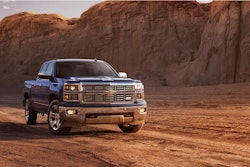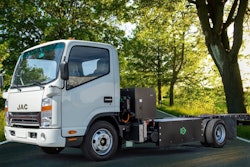 Ford is licensing to other automakers its robotic testing technology used to ensure Ford trucks, including the all-new 2017 F-Series Super Duty, can endure its most rigorous test-drive courses.
Ford is licensing to other automakers its robotic testing technology used to ensure Ford trucks, including the all-new 2017 F-Series Super Duty, can endure its most rigorous test-drive courses.Autonomous driving technology continues to improve.
In this case, over the past two years Ford and Autonomous Solutions Inc. have worked together to create an autonomous driving system that is now used to test-drive Ford trucks over their toughest obstacle courses, minus their vulnerable human counterparts.
Major automakers have now lined up, Ford says, to buy the patented system.
“This robotic testing kit is available to purchase directly from ASI immediately,” says Chris Danowski, director of technology commercialization and intellectual property licensing, Ford Global Technologies. “Several automotive OEMs have already placed orders to purchase systems for their own testing.”
It takes about 90 minutes or so to outfit a vehicle with all of the components necessary for automation, according to Ford Product Communications Publicist Sam Schembari. The robot vehicles not only speed up test-driving, they also remove a liability: people.
“A human driver is limited to the amount of time they can spend behind the wheel because the roads they drive over during testing are so severe that extended driving times can injure their bodies,” Schembari says. “With the robot we don have to do one drive and stop. The robots don’t have time limitations that humans do.”
Robotically driven vehicles are expected to repeatedly perform tests on torturous surfaces with names like Silver Creek, Power Hop Hill and Curb Your Enthusiasm. These tests can compress 10 years of daily driving abuse into courses just a few hundred yards long, with surfaces that include broken concrete, cobblestones, metal grates, rough gravel, mud pits and oversized speed bumps.
The innovative technology is helping to ensure the all-new 2017 F-Series Super Duty has undergone the equivalent of years of abuse and durability testing in a short amount of time to better ensure it will hold up to the hard work its owners expect.
During testing, Ford engineers who closely monitor the vehicles can quickly gain control of the system if necessary. Sensors on the vehicle maintain a constant vigilance and will quickly brake for the unexpected, such as a person that may enter its path. GPS technology paired up with sophisticated software enables the robotic vehicle to stay on course.
Utah-based ASI had already been developing and selling autonomous vehicle control systems before partnering with Ford to make improvements on the technology. Their website reports that a fleet equipped with their autonomous system outperformed a manned fleet by 12 percent.
“We’re proud to work with Ford to help develop this technology and to be granted a license from Ford Global Technologies,” says ASI CEO Mel Torrie. “The enhancements we’ve made with Ford will improve the durability, reliability and performance of these systems, allowing for even more accurate testing and higher-quality vehicles.”
Schembari would not reveal the price of the robotic system or the auto manufacturers that are buying it. The robotic systems will not replace all human drivers, just the ones that once suffered through Ford’s toughest courses, Schembari said.









